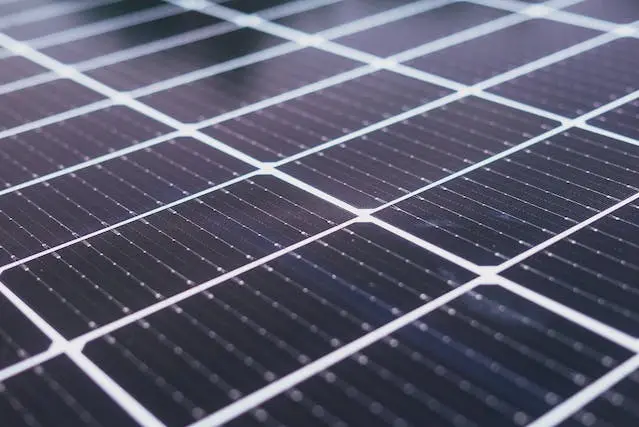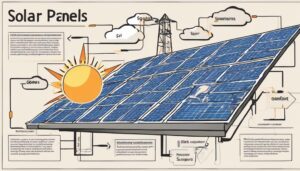You might not be aware that the heat generated by your solar heating system can be significantly influenced by the chill that seeps in through poorly insulated areas. As you strive for a greener lifestyle and lower energy bills, it’s vital to understand that the efficiency of your solar heating system isn’t solely dependent on the panels themselves. The ancillary components play a crucial role too.
From the insulation of water storage tanks to the seals around your doors and windows, each element can either contribute to heat retention or result in unnecessary loss. By upgrading to insulated piping and installing heat traps, you can ensure that the warmth your system captures isn’t slipping away.
Imagine the satisfaction you’ll feel when you’ve fine-tuned your system to operate at its peak, now, let’s explore how you can achieve this and maintain a cozy, cost-effective home.
Key Takeaways
- Insulating the water storage tank and piping reduces heat loss and conserves energy in a solar heating system.
- Heat traps capture and retain heat within the system, maximizing energy savings and reducing operational costs.
- Low-E windows act as a barrier to heat flow, optimizing energy efficiency and maintaining a consistent indoor climate.
- Properly sealing doors and windows with weather stripping and caulking enhances the efficiency of a solar heating system and reduces heat loss.

Insulate Water Storage
To boost your solar heating system’s performance, it’s crucial to insulate the water storage tank, as this step significantly curtails heat loss and keeps your water warm for longer. Understanding the water tank insulation benefits will have you wrapping up your system in no time.
By insulating, you’re not just maintaining toasty temperatures; you’re also reducing energy consumption. That’s because your system won’t have to work overtime reheating water, which means you’re conserving energy and, ultimately, cutting costs.
Let’s talk about the types of insulation materials you can choose from. There’s a variety, each with its strengths. Foam insulation bats snugly wrap around your tank, while rigid foam boards can be cut to fit and offer sturdy coverage. Reflective foils can act like a thermal mirror, bouncing heat back into the tank. Even spray foam can fill in the nooks and crannies, ensuring a tight seal.
Upgrade to Insulated Piping
Just as a warm jacket keeps you cozy in winter, upgrading to insulated piping ensures that your solar-heated water loses as little heat as possible on its journey to you. By investing in this simple yet effective enhancement, you’ll lock in the heat, ensuring that the energy captured by your solar panels isn’t wasted before it reaches its destination.
Here’s how insulated piping benefits your system:
- Reduces Heat Loss: Insulated pipes keep the water temperature consistent from the collector to the tank, minimizing the energy needed to reheat the water.
- Increases Energy Efficiency: By preventing heat from escaping, your system uses less energy to maintain water temperature, saving you money on utility bills.
- Improves System Performance: With a more stable temperature, the solar heating system operates optimally, providing a reliable supply of hot water.
Diving into the installation process, you’ll find it straightforward. First, you’ll select the appropriate insulation material and thickness based on your climate and system specifications. Then, the insulation is applied to all exposed piping, securing it in place to prevent any thermal bridges where heat can escape.

Install Heat Traps
Installing heat traps in your solar heating system is an effective strategy to curb heat loss and boost overall efficiency. These devices are essential for maximizing energy savings by capturing and retaining heat within the system. By ensuring proper heat trap maintenance, you’re not only extending the life of your system but also ensuring it works at peak performance.
Here’s a quick breakdown of what you need to know about heat traps:
|
Aspect
|
Benefit
|
Maintenance Tip
|
|---|---|---|
| Heat Retention | Reduces energy wastage | Regularly check for blockages |
| Improved Efficiency | Cuts down operational costs | Inspect for wear and tear |
| Energy Savings | Lowers utility bills | Schedule professional check-ups |

Low-Emissivity Window Solutions
While addressing heat loss through heat traps significantly enhances a solar heating system’s performance, complementing this effort with Low-Emissivity window solutions can further optimize your home’s energy efficiency. Low-E windows, or energy-saving glass, are designed to minimize the amount of infrared and ultraviolet light that passes through glass without compromising the amount of natural light that enters your home. These windows have a microscopically thin coating that’s transparent and reflects heat.
Here’s why you should consider Low-E windows for your solar-heated home:
- Thermal Insulation: Low-E windows act as a barrier to heat flow, keeping your home warmer in the winter and cooler in the summer. This thermal insulation reduces the strain on your heating and cooling system, which in turn lowers your energy bills.
- Consistent Indoor Comfort: By reducing temperature fluctuations, Low-E windows help maintain a consistent and comfortable indoor climate. You won’t have to adjust the thermostat as often, leading to additional energy savings.
- Protection for Interiors: These windows not only save energy but also protect your interior furnishings by blocking harmful UV rays, which can fade colours and degrade materials over time.
Enhance Door and Window Seals
To further elevate your solar heating system’s efficiency, start by ensuring that your doors and windows are properly sealed. Drafty entrances can let the warmth slip away, undermining the effectiveness of your solar heating. Replace worn-out weather stripping around these areas to maintain a snug barrier against the cold. This not only keeps the heat in but also saves you money on energy bills.
Door sweeps are another smart addition; they prevent chilly air from sneaking in under the doors. Inspect your doors and windows for any gaps or cracks that can be sealed off with caulking. This simple fix can make a significant difference in retaining heat.
Consider double-glazed windows as a longer-term investment. They consist of two layers of glass with an insulating space in between, greatly enhancing the thermal efficiency of your home. Here’s a quick comparison:
|
Single Glazed Windows
|
Double Glazed Windows
|
|---|---|
| Poor insulation | Better insulation |
| More heat loss | Reduced heat loss |
| Noisy | Soundproofing |
Enhancing door and window seals is a cost-effective way to maximize your solar heating system’s potential. It’s an investment in comfort and efficiency that pays off season after season.

Surprising Facts About The Solar Heating System In Australia
- ☀️ Australia’s abundant sunshine makes solar heating systems highly viable. The country receives an average of 58 million PJ (petajoules) of solar radiation each year, providing an ample resource for solar energy technologies.
- 🌡️ Solar water heating systems are popular in Australia, especially for residential use. These systems use rooftop collectors to absorb sunlight and heat water for domestic purposes, such as showers and household chores.
- 🏡 Many Australian households use solar hot water systems as an alternative to traditional electric or gas heaters. These systems can significantly reduce energy bills and greenhouse gas emissions.
- 🌐 In remote areas where connecting to the electricity grid is impractical, standalone solar water heaters offer a sustainable solution. These systems provide reliable hot water without relying on conventional power sources.
- 💡 Solar pool heating is a common practice in Australia, where many households have swimming pools. Solar collectors circulate pool water through them, utilizing the sun’s heat to warm the water before returning it to the pool.
- 🌍 Government incentives, such as the Small-scale Renewable Energy Scheme (SRES) and various state-based initiatives, encourage the adoption of solar heating technologies across residential and commercial sectors.
- 🌞 Australia’s commitment to renewable energy is evident in solar heating installations for commercial and industrial purposes. Solar thermal systems are employed in some industries to meet their process heat requirements.
- 🛠️ Innovations in solar heating technology include the integration of heat pumps with solar systems. This combination enhances efficiency by using electricity only when necessary, making the most of both technologies.
- 🏘️ Community-based solar heating projects are emerging, where multiple households share a centralized solar water heating system. This approach promotes efficiency and affordability while reducing the carbon footprint.
- 🌱 Australia’s focus on sustainability extends to research and development in solar heating. Ongoing efforts aim to enhance the efficiency and affordability of solar heating systems, contributing to a cleaner and greener energy future.
Frequently Asked Questions
At What Temperature Do Solar Panels Become Less Efficient?
Your solar panels start losing efficiency above 25°C due to heat dissipation issues. The temperature threshold is exceeded, and for every degree rise, expect up to a 0.5% drop in performance. Keep ’em cool!
What Is the Efficiency of Solar Thermal Heating System?
You’re looking at solar thermal heating systems, where efficiency hinges on heat retention and system design. It’s not just about sunlight; it’s how well the system captures and keeps that heat for you.
Are Cold Climates Optimal for Solar Panel Efficiency?
Yes, cold climates can be optimal for solar panel efficiency. Contrary to solar misconceptions, cooler temperatures improve performance. Just remember, insulation importance can’t be overstated to maintain energy gains in chilly conditions.
Does Cooling Solar Panels Make Them More Efficient?
Yes, cooling your solar panels can boost their efficiency. Heat dissipation is key; consider panel coatings that reflect excess heat to keep temperatures down and your system running more effectively.
Conclusion
In conclusion, maximizing the efficiency of your solar heating system goes beyond just having high-quality panels. By insulating the water storage tank and upgrading to insulated piping, you can significantly reduce heat loss and conserve energy. Installing heat traps further enhances efficiency by capturing and retaining heat within the system.
Additionally, incorporating low-emissivity windows and properly sealing doors and windows with weather stripping and caulking helps maintain a consistent indoor climate while reducing heat loss.
These simple yet effective strategies not only increase energy savings but also contribute to a cozy, cost-effective, and eco-friendly home. With Australia’s abundant sunshine and various government incentives, solar heating systems are a viable and sustainable solution for residential and commercial use.
As the country continues to focus on renewable energy, ongoing research and development aim to enhance the efficiency and affordability of solar heating systems, paving the way for a cleaner and greener energy future.



